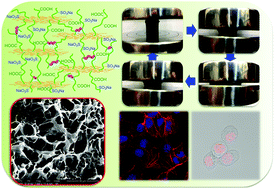In this study, we report the rapid synthesis of robust, highly elastic and bioactive heparin-mimetic hydrogels by combining free radical polymerization with doped graphene oxide (GO) as the micro-crosslinker. In the hydrogel system, GO is covalently connected or bonded to the heparin-mimetic polymer networks since the initiated macromolecular radicals can attach to the double bonds of GO. As a result, the GO doped heparin-mimetic hydrogels reveal highly interpenetrating networks with increased small pores, thinner pore walls, and a narrow pore size distribution compared to pristine heparin-mimetic hydrogels. Meanwhile, the GO doped heparin-mimetic hydrogels can also sustain cyclic compressions with extremely high strain due to the reinforced mechanical strength and elastic properties. Furthermore, all of the heparin-mimetic hydrogels show excellent endothelial cell compatibility, and doping with GO can further improve the cell viability and promote the generation of actin filaments and extracellular matrix. Moreover, the heparin-mimetic hydrogels also show a high drug loading ability and a persistent releasing ability, thus exhibiting sustained antitumor cell activity; doping with GO can help achieve more slow doxorubicin (DOX) release and better anti-cancer efficiency than the pristine hydrogel. Combined with the excellent properties mentioned above, we believe that the synthesized GO doped heparin-mimetic hydrogels will have great potential for application in various biomedical fields, such as tissue engineering and implantable drug delivery systems.
